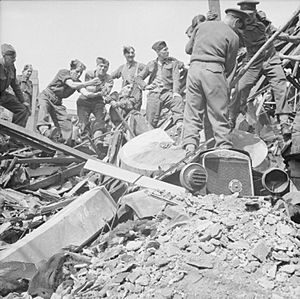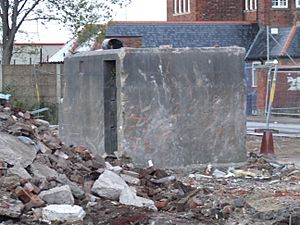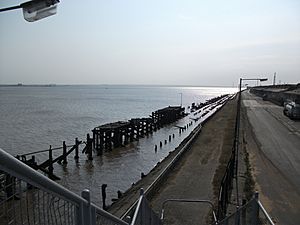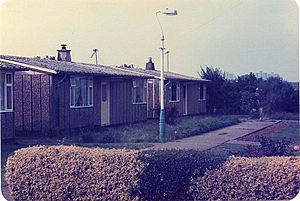Hull Blitz facts for kids
Quick facts for kids Hull Blitz |
|||||||
|---|---|---|---|---|---|---|---|
| Part of the Strategic bombing campaign of World War II | |||||||
 Troops of 9th Battalion, The Hampshire Regiment, helping to clear bomb damage in Hull. |
|||||||
|
|||||||
| Belligerents | |||||||
| Casualties and losses | |||||||
| Unknown | ~1,200 | ||||||
The Hull Blitz was a series of heavy bombing attacks on the English port city of Kingston upon Hull. These attacks were carried out by the German Luftwaffe (air force) during World War II. Hull was a very important target because of its busy port and factories.
Many large attacks happened in March 1941, killing over 200 people. The worst attacks were on the nights of May 7 and 8, 1941, which caused nearly 400 deaths. Another big attack in July 1941 killed 143 people.
Hull was under air raid alert for more than 1,000 hours between 1940 and 1945. Almost 1,200 people in the city died because of the bombing.
Contents
Impact of the Hull Blitz
Hull was one of the most damaged cities in Britain during the Second World War. About 95 percent of its houses were hit. The city was under air raid warnings for a total of 1,000 hours. Hull also experienced the first daylight air raid of the war and the very last piloted air raid on Britain.
At the start of the war, Hull had about 320,000 people. Around 152,000 of them lost their homes due to bomb damage. In total, nearly 1,200 people were killed and 3,000 were injured.
More than 5,000 houses were completely destroyed. Half of the city centre was also ruined. The damage cost was estimated at £20 million in 1952. Many factories, oil and flour mills, and the Riverside Quay were destroyed. Also, 27 churches, 14 schools or hospitals, 42 pubs, and 8 cinemas were ruined. Only 6,000 out of 91,000 houses were left undamaged by the end of the war.
Despite all this damage, Hull's port kept working throughout the war. It was vital for bringing supplies into Britain.
We lived in the middle of an industrial area that was a regular target for German bombers .. One night as we were all filing into the air raid shelter Mam dashed back into the house. "Where are you going, Mary," said Dad. "Back for my false teeth," she replied. "Come back here, the Germans are dropping bombs not meat pies," shouted Dad.
—Norman Collier, Comedian, Hull
History of Bombing in Hull
Early Attacks and Preparations
Hull had been bombed before, during the First World War, by German airships called Zeppelins. In June 1915, a Zeppelin raid destroyed 40 houses and killed 24 people. These early attacks showed that Hull needed better protection from bombs.
Because of this, a program to build air raid shelters started in 1938. Over £1.5 million was spent building 40,000 shelters across the city.
At the beginning of the Second World War in 1939, ten main targets were identified in Hull. These included the water works, gas works, power station, oil refinery, and the six docks. Large grain mills on the River Hull were also important targets.
The Blitz Begins: 1940
Hull's first air-raid warning was on September 4, 1939. However, no bombs were dropped that day.
The attacks on Hull in 1940 were not very big. They were usually carried out by one or a few planes. The first recorded bombing raid was on the night of June 19/20, 1940. By the end of the year, about 20 raids had happened, and 12 people had been killed.
One air raid on the oil depot at Saltend, east of Hull, caused a huge fire. Five brave men were given the George Medal for their courage in putting out the fire.
Intense Bombing: 1941
The bombing became much more intense in early 1941. In February, several attacks killed about 20 people. In March, major raids took place on the nights of the 13th, 14th, and 18th.
- The first big attack hit businesses along the River Hull.
- The second hit St Andrew's Dock. A public shelter nearby was hit by a "parachute mine," killing many people.
- The third major raid lasted six hours and killed nearly 100 people. Bombs fell all over Hull, especially near the River Hull.
On March 31/April 1, the city centre was targeted, mainly with parachute mines. From March to April, bombing killed 200 people.
Attacks continued in April. A major attack on April 15/16 focused on Alexandra Dock. Another parachute mine hit a public shelter, killing over 4 people. More mine attacks happened between April 25 and 27, killing six people in the Gipsyville area.
From May 3 to 9, the docks and city centre were heavily targeted. These attacks were part of a larger German bombing campaign against British ports. Two major attacks on May 7 and 8 each lasted about 5–6 hours. They used high explosives, parachute mines, and many incendiary bombs (bombs designed to start fires).
During these attacks, many famous buildings were damaged or destroyed. These included department stores like Hammonds and Edwin Davis. The Riverside Quay at the docks was destroyed by fire. The Rank Flour Mill and the bus depot were also damaged. Over 400 people were killed in these attacks. Many died because bombs hit public bomb shelters.
The anti-aircraft guns and searchlights defending Hull tried their best. They, along with night fighter planes, managed to shoot down some German bombers. In one amazing event on May 8/9, a soldier named Gunner Maycock shot down a German Heinkel He 111 bomber using a light machine gun from a river barge.
After Germany started its war against Russia in June 1941, attacks on England became less frequent. This was because many German planes moved to the eastern front. However, attacks on Hull continued off and on through late May, June, and July. A major attack on July 18/19 hit east Hull and the Victoria Dock. About 140 people were killed in this raid.
Many people in Hull started "trekking." This meant leaving the city at night to sleep in the countryside when bombing was expected. By 1941, about a third of the population was doing this. In August 1941, King George VI and Queen Elizabeth visited Hull to see the damage.
Minor attacks continued about once a month until the end of the year. Serious bombings happened on August 18 and August 31/September 1.
Later Attacks: 1942–1945
Attacks in 1942 were fewer than in 1941. A major bombing raid on May 19/20 targeted Alexandra and Victoria docks. Bombs were also dropped on residential areas, killing 4 people. These attacks on the docks were likely meant to stop supplies from reaching Russia. By this time, bombs were much heavier, with 500 kg bombs being common. On August 1, another raid on the eastern docks killed 24 people when a very large 1,800 kg bomb hit Grindell Street. There were also attacks in October and December, but they caused less damage and killed only two people each.
Small attacks happened on January 3 and 15, 1943. In the second attack, "phosphorus bombs" were used to start fires.
On June 24, 1943, a larger attack targeted the city centre again. During this raid, the well-known Hull Municipal Museum was destroyed by fire. The government allowed Hull to be named as the target of this attack. The Hull Daily Mail newspaper reported it on its front page the next day. Another attack on July 13/14 seemed to aim at the railway system and killed more than 20 people. Two more attacks later that year did not cause much damage.
No bombs fell on Hull in 1944.
In March 1945, the city was attacked by planes firing cannon shells. There was also an attack on March 17/18, with fragmentation grenades being dropped.
Bombing in East Yorkshire
The bombing campaign in Britain killed 121 people in the wider East Riding of Yorkshire area. This included 82 civilians and 39 military personnel. The Luftwaffe also targeted coastal towns like Bridlington, Hornsea, and Withernsea, killing 44 people. RAF airfields such as RAF Driffield were also bombed. An attack on RAF Driffield on August 15, 1940, killed 15 people.
Other attacks in East Yorkshire were near Hull. These included the first daylight raid on British soil at the Saltend oil terminal. The Blackburn Aircraft factory at Brough was also attacked. Sometimes, bombs were dropped by mistake because pilots got lost or aimed for decoy targets set up to protect Hull Docks. These accidental bombings killed 22 people in Hedon, Bilton, and Preston. German planes also sometimes dumped bombs after giving up on raids meant for other northern cities like Manchester or Leeds.
On December 24, 1944, a large attack of V-1 flying bombs was launched towards Manchester. One of these bombs hit early at Willerby, just outside Hull. It damaged houses and the Springhead Pumping Station.
Children Evacuated from Hull
About 38,000 children were sent away from Hull to safer places. They went to rural areas in East Yorkshire and Lincolnshire, and also to counties like Lancashire and Norfolk. Entire secondary schools were moved. For example, Hymers College pupils went to Pocklington and Market Weighton. Newland High School moved to Bridlington and later to Malton. However, many students stayed in the city, and most evacuees returned from late 1942 onwards.
How the News Was Reported
During the war, radio and newspaper reports usually did not name Hull specifically. They would call it a "north-east coast town" or "northern town." This was done to prevent the enemy from knowing exactly where the damage was. After the major raids in March, July, and August 1941, and June 1943, the city was named. But for the attacks in May 1941, the target was simply called an area in the "Humber."
The Hull Daily Mail newspaper named the victims of the bombings. However, it did not report specific locations or industrial damage. Damage to schools and churches was reported openly. German press releases, including the name of the town, were sometimes quoted directly in British newspapers.
OUR OBJECTIVE: THE SUPPLY PORT OF HULL The British Port of Hull, with its multi-purpose dockyards, its wharves and its strategically important industrial sites – this was our target yet again today. Along with the other aircrews of our unit, we took off last night, having taken aboard the bomb load which we intended to deposit to good effect in the middle of the great dockyards .. [...]
—Luftwaffe report (19 June 1941, [translation] German Federal Archives)
Hull's Legacy After the Blitz
After the war, the city of Hull was rebuilt. A big plan called the "Abercrombie Plan" was created, but it was not fully carried out. Some areas remained undeveloped even into the 1980s.
At the site of the Hull Municipal Museum, which was destroyed by fire during the Blitz, many items from its collection were found again in the 1990s during building work. They were recovered by archaeologists.
The old National Picture Theatre was hit by a large parachute landmine in 1941. This blew off the back of the building. The shell of the building remained standing for sixty years. It became one of the last visible bomb sites in Britain. Because of its history, the building was given special protection in 2007.
One strange fact about the bombing was the Hull factory of the National Radiator Company Ltd.. Not a single German bomb fell on this factory during the entire war. This is despite it being a huge 55-acre site and having been used to make weapons in the First World War. German bombing maps even showed it as a target for a raid in April 1941.
The Hull Blitz was also a big part of a light show in Queen Victoria Square, Hull, in January 2017. This event celebrated the history of Hull as part of the Hull UK City of Culture 2017 celebrations.
See also
- Closed cinemas in Kingston upon Hull
- Strategic bombing during World War II





